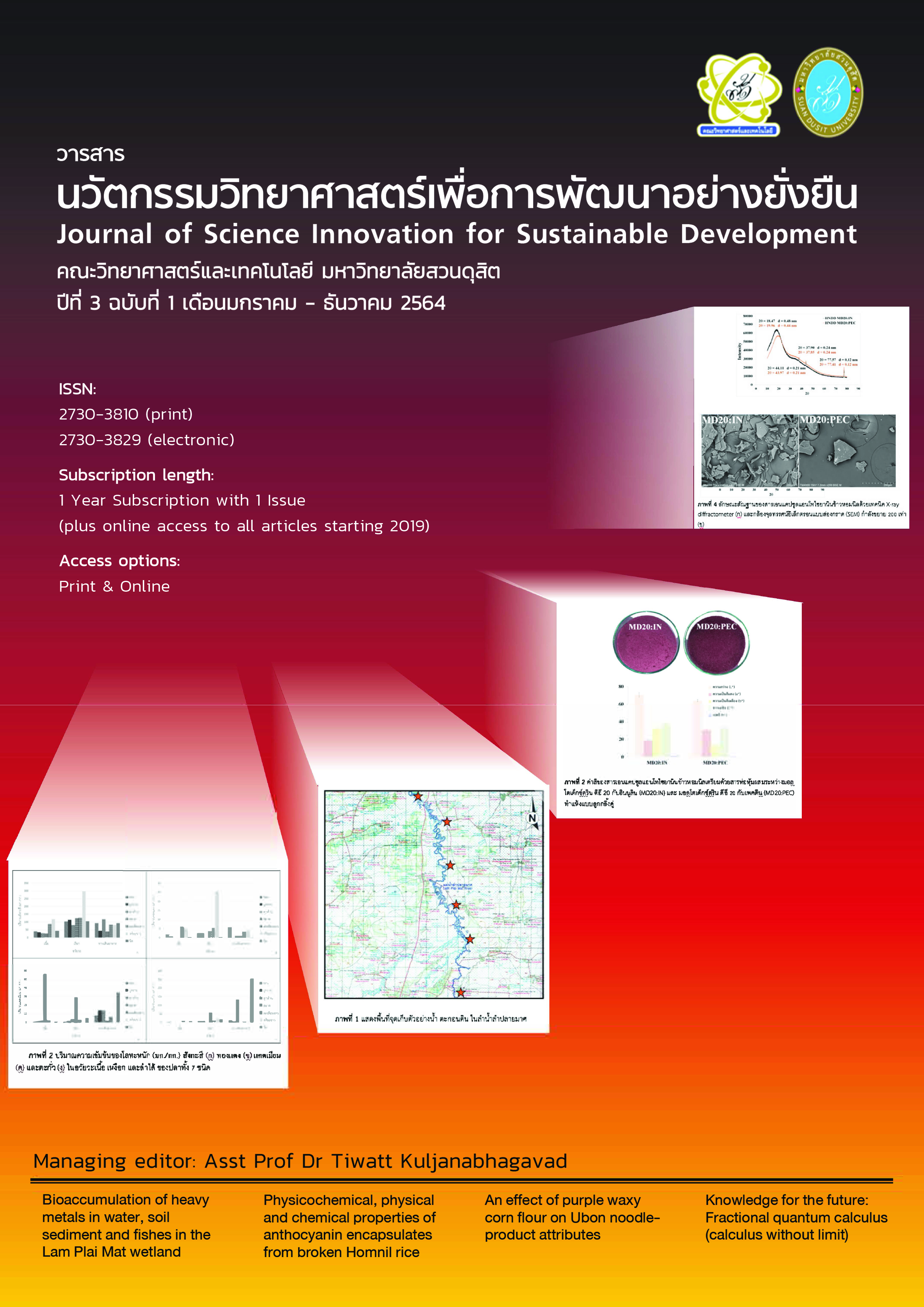ผลของแป้งข้าวโพดข้าวเหนียวก่ำต่อคุณภาพของผลิตภัณฑ์เส้นกวยจั๊บอุบล อัตรพร นิยมรัมย์ อัมพิการ์ ว่องไวย์ นิตยา ภูงาม* ณัฎวลิณคล เศรษฐปราโมทย์ และ วีรเวทย์ อุทโธ
Main Article Content
บทคัดย่อ
งานวิจัยนี้เป็นการศึกษาผลิตภัณฑ์เส้นกวยจั๊บอุบลที่เสริมด้วยแป้งข้าวโพดข้าวเหนียวก่ำที่ระดับ ร้อยละ 0 5 10 และ15 จากการประเมินทางด้านประสาทสัมผัสที่ได้รับการยอมรับ คือ สูตรที่ร้อยละ 10 ซึ่งมีคะแนนทางด้านเนื้อสัมผัส (ความเหนียว) และความชอบโดยรวมในระดับสูง (7.20 และ7.37) เมื่อเปรียบเทียบสูตรที่ระดับร้อยละ 5 และ15 และมีค่าใกล้เคียงกับสูตรควบคุม (Control) การศึกษาคุณลักษณะทางกายภาพของเส้นกวยจั๊บอุบลเสริมแป้งข้าวโพดข้าวเหนียวก่ำที่ระดับ ร้อยละ 10 เปรียบเทียบกับสูตรควบคุม (Control) พบว่า เส้นกวยจั๊บอุบลทั้ง 2 สูตร ไม่มีความแตกต่างอย่างมีนัยสำคัญทางสถิติ (p≤0.05) ของค่าความชื้น (2.51 และ 2.30% ตามลำดับ) และค่า Water activity (aw) (0.68 และ 0.79 ตามลำดับ) เมื่อพิจารณาค่าแรงดึงสูงสุดของเส้นกวยจั๊บ แสดงให้เห็นว่าสูตรเสริมแป้งข้าวโพดร้อยละ 10 มีค่าสูงกว่า (11.06 N) เมื่อเปรียบเทียบกับสูตรควบคุม (9.24 N) การเสริมแป้งข้าวโพดส่งผลให้มีปริมาณโปรตีน ไขมัน เถ้า อะไมโลส สารประกอบฟินอลิก สารต้านอนุมูลอิสระ และแอนโทไซยานิน มีแนวโน้มสูงกว่าสูตรควบคุม (3.40, 1.83, 1.20, 18.99%, 18.04 mgGAE/100 g, 31.70 mg/ml และ 44.37 mg ตามลำดับ) ดังนั้นจึงเหมาะในการเสริมคุณค่าทางสารอาหารให้กับผลิตภัณฑ์เส้นกวยจั๊บอุบลทดแทนสูตรดั้งเดิมที่ผู้บริโภคจะได้สารอาหารจำพวกคาร์โบไฮเดรตเป็นหลัก
Article Details

อนุญาตภายใต้เงื่อนไข Creative Commons Attribution-NonCommercial-NoDerivatives 4.0 International License.
ลิขสิทธิ์ต้นฉบับที่ได้รับการตีพิมพ์ในวารสารนวัตกรรมวิทยาศาสตร์เพื่อการพัฒนาอย่างยั่งยืนถือเป็นกรรมสิทธิ์ของคณะวิทยาศาสตร์และเทคโนโลยี มหาวิทยาลัยสวนดุสิต ห้ามผู้ใดนำข้อความทั้งหมดหรือบางส่วนไปพิมพ์ซ้ำ เว้นแต่จะได้รับอนุญาตอย่างเป็นลายลักษณ์อักษรจากคณะวิทยาศาสตร์และเทคโนโลยี มหาวิทยาลัยสวนดุสิต นอกจากนี้ เนื้อหาที่ปรากฎในบทความเป็นความรับผิดชอบของผู้เขียน ทั้งนี้ไม่รวมความผิดพลาดอันเกิดจากเทคนิคการพิมพ์
เอกสารอ้างอิง
กรมวิชาการเกษตร. (2547). ข้าวโพดเลี้ยงสัตว์. กระทรวงเกษตรและสหกรณ์, กรุงเทพมหานคร.
กฤติมา นพกรมงคล, ปิยนันท์ แสนกล้า และปวีณา เฉลียวไว. (2557). การใช้แป้งข้าวไรซ์เบอรี่ทดแทนแป้งสาลีในขนมปังหวาน. ปริญญานิพนธ์วิทยาศาสตรบัณฑิต. มหาวิทยาลัยเทคโนโลยีราชมงคลพระนคร, กรุงเทพมหานคร.
การะเวก. (2551). ใครชอบกวยจั๊บอุบล เชิญมาแวะจ้า. สืบค้นเมื่อ 26 มีนาคม 2564. จาก:http://topicstock.pantip.com/food/topicstock/2008/01/D6289009/D6289009.html.
จตุพัฒน์ สมัปปิโต, ปนัดดา พงษ์ธนู และ สุพาลัย แมลงผึ้ง. (2563). การศึกษาคุณสมบัติทางเคมีและการประเมินคุณลักษณะทางประสาทสัมผัสของโยเกิร์ตพร้อมดื่มจากข้าวโพดข้าวเหนียวสีม่วง. งานประชุมวิชาการระดับชาตินนทรีอีสาน ครั้งที่ 8 ประจำปี 2563. มหาวิทยาลัยราชภัฏบุรีรัมย์, บุรีรัมย์.
จิตรา สิงห์ทอง. 2555. วิทยาศาสตร์บูรณาการกับภูมิปัญญาท้องถิ่นเพื่อสุขภาพและชุมชนใน การศึกษาด้านการพัฒนาเส้นกวยจั๊บอุบลกึ่งสำเร็จรูปเสริมรำข้าว. รายงานฉบับสมบูรณ์สำนักบริหารโครงการวิจัยในอุดมศึกษาและพัฒนามหาวิทยาลัยแห่งชาติสำนักคณะกรรมการการอุดมศึกษา มหาวิทยาลัยอุบลราชธานี, อุบลราชธานี.
จิตรา สิงห์ทอง. (2556). ผลของไฮโดรคอลลอยด์ต่อการปรับปรุงคุณภาพของเส้นกวยจั๊บอุบล. สาขาวิชาอุตสาหกรรมเกษตร. คณะเกษตรศาสตร์และเทคโนโลยี. มหาวิทยาลัยอุบลราชธานี.
จิตรา สิงห์ทอง. (2560). ผลิตภัณฑ์เส้นกวยจั๊บอุบลกึ่งสำเร็จรูปเพื่อสุขภาพจากแป้งแก่นตะวัน. สาขาวิชาอุตสาหกรรมเกษตร. คณะเกษตรศาสตร์และเทคโนโลยี. มหาวิทยาลัยอุบลราชธานี.
จินดาพร คงเดช. (2551). การผลิตสารยับยั้งเอนไซม์ไทโรซิเนสและสารต้านอนุมูลอิสระจากพืช เพื่อใช้ในการผลิตเครื่องสำอาง. วิทยานิพนธ์วิทยาศาสตรมหาบัณฑิต. มหาวิทยาลัยเทคโนโลยีพระจอมเกล้าธนบุรี, กรุงเทพมหานคร.
ทัตดาว ภาษีผล, รัตนา ประทุม และสุนิสา สุริยขันธ์. (2561). องค์ประกอบทางพฤกษเคมีและปริมาณฟีนอลิกทั้งหมดของสารสกัดจากไหมข้าวโพดสองสี. วารสารแก่นเกษตร. 46(ฉบับพิเศษ). 1315–1320.
นุชรินทร์ กาฬเนตร, อุราวรรณ มุลสุรินทร์, นภมณี มงคลประเสริฐ และกิตติพร สุพรรณผิว. (2552). การพัฒนาผลิตภัณฑ์เส้นกวยจั๊บจากแป้งข้าวกล้องเสริมงาดำ. วารสารการเกษตรราชภัฏ, 8(2), 15–25.
บัวริม บุญกระโทก. (2546). การสร้างพันธุ์ลูกผสมเดี่ยวเบื้องต้นของข้าวโพดเทียนโดยวิธี Testcross. วิทยานิพนธ์วิทยาศาสตรมหาบัณฑิต. มหาวิทยาลัยแม่โจ้, เชียงใหม่.
ปิติพร ฤทธิ์เรืองเดช. (2546). คุณสมบัติทางกายภาพและทางเคมีของแป้งเท้ายายม่อมและการนำไปใช้ประโยชน์ในขนมชั้น. วิทยานิพนธ์วิทยาศาสตรมหาบัณฑิต. มหาวิทยาลัยเกษตรศาสตร์, กรุงเทพมหานคร.
ภัทราวดี วงษ์วาศ์, นครินทร์ ศรีปัญญา และวิชุดา ตามัย. (2561). การพัฒนาผลิตภัณฑ์เส้นกวยจั๊บญวนจากแป้งข้าวไรซ์เบอรี่ผสมน้ำสกัดสมุนไพร. วารสารวิทยาศาสตร์เกษตร. 49(2)(ฉบับพิเศษ). 581–584.
พรทวี ธนสัมบัณณ์ จันทร์จนา ศิริพันธ์วัฒน สาวิตรี ประสิ่งชอบ และนิตยา งามเสงี่ยม. (2557). การทดแทนเนื้อตาลผงในผลิตภัณฑ์บะหมี่สด. วารสารวิจัยมหาวิทยาลัยสวนดุสิต. 7(1). 321–329.
เพ็ญขวัญ ชมปรีดา. (2549). การประเมินคุณภาพทางประสาทสัมผัส. มหาวิทยาลัยเกษตรศาสตร์, กรุงเทพมหานคร.
รวิกานต์ ภู่หล่ำ. (2559). ราชินีทับทิมสยาม ข้าวโพดหวานพิเศษสีแดงสายพันธุ์แรกของโลก. สืบค้นเมื่อ 28 กันยายน, 2563, จาก: http://agt.snru.ac.th/topics/3536.
ศรีวัฒนา ทรงจิตสมบูรณ์. (2548). การศึกษาสมบัติการต้านอนุมูลอิสระของสารสกัดจากต้นพันงูเขียว. วารสารวิทยาศาสตร์เกษตร. 41(3/1) (ฉบับพิเศษ). 329–332.
สุภาพร ฟักเงิน และศิรประภา มีรอด. (2560). การสกัดแยกหาปริมาณแอนโทไซยานินจากลูกมะม่วงหาว มะนาวโห่. การประชุมวิชาการระดับชาติ ครั้งที่ 4 สถาบันการวิจัย มหาวิทยาลัยราชภัฏกำแพงเพชร. กำแพงเพชร.
Abirami, S., Priyalakshmi, M., Soundariya, A., Samrot, A. V., Saigeetha, S., Emilin, R. R., Dhiva, S., Inbathamizh, L. (2021). Antimicrobial activity, antiproliferative activity, amylase inhibitory activity and phytochemical analysis of ethanol extract of corn (Zea mays L.) silk. Current Research in Green and Sustainable Chemistry. 4. 1–6.
AOAC. (2005). Official method of Analysis of the Association of Officiating Analytical. Chemists international. 18th Edition, Washington DC.
AOAC. (2011). Official Methods of Analysis of the Association of Official Analytical. Chemists international. 18th Edition, Gaithersburg.
Boukaew, S., Prasertsan, P. and Sattayasamitsathit, S. (2017). Evaluation of antifungal activity of essential oils against aflatoxigenic Aspergillus flavus and their allelopathic activity from fumigation to protect maize seeds during storage. Industrial Crops and Products. 97. 558–566.
CRA. (2006). Corn oil (5th ed.). Washington, DC: Corn Refiners Association.
Gopalan, C., Rama Sastri, B. V., & Balasubramanian, S. (2007). Nutritive value of Indian foods. Hyderabad: National Institute of Nutrition (NIN), ICMR.
Jarnsuwan, S., and Thongngam, M. (2011). Effects of hydrocolloids on microstructure and textural characteristic of instant noodles. In proceeding in the Asian Food Conference 2011, 16–18 June 2011. Bitec, Bangkok. 632–635.
Jiang, Y. Z. and Wang, T. (2005). Phytosterols in cereal byproducts. Journal of the American Oil Chemists’ Society. 82. 439–444.
Kim, J. T., Chung, I. M., Kim, M. J., Lee, J. S., Son, B. Y., Bae, H. H., Go, Y. S. Kim, S. L., Baek, S. B., Kim, S. H. and Yi, G. (2022). Comparison of antioxidant activity assays in fresh purple waxy corn (Zea mays L.) during grain filling. Applied Biological Chemistry. 65(1). 1–7.
Keppel, G. (1982). Design and analysis A researchers hand book. Prentice-Hall, New Jersey.
Kopsell, D. A., Armel, G. R., Mueller, T. C., Sams, C. C., Deyton, D. E., McElroy, J. S. and Kopsell, D. E. (2009). Increase in nutritionally important sweet corn kernel carotenoids following mesotrione and atrazine applications. Journal of Agricultural and Food Chemistry. 57(14). 6362–6368.
Lopez-Martinez, L. X., Oliart-Ros, R. M., Valerio-Alfaro, G., Lee, C.H., Parkin, K. L., and Garcia, H. S. (2009). Antioxidant activity, phenolic compounds and anthocyanins content of eighteen strains of Mexican maize. LWT - Food Science and Technology. 42(6). 1187–1192.
Romas-Eseudero, F., Munez, A. M., Alvarade-Ortiz, A. A. and Yanez, J. A. (2012). Purple corn (Zea mays L.) phenolic compound profile and its assessment as an agent against oxidative stress in isolated mouse organs. Journal of Medicinal Food. 15(2). 206–215.
Saerpoua, E., Tangwongchai, R., Suriharn, B. and Lertrat, K. (2013). Relationships between phytochemicals antioxidant activity in corn silk. International Food Research Journal. 20 (5). 2073–2079.
Shah, T. R., Prasad, K., and Kumar, P. (2015). Studies on physicochemical and functional characteristics of Asparagus bean flour and maize flour. In G. C. Mishra (Ed.), Conceptual frame work & innovations in agroecology and food sciences (1st ed., pp. 103–105). New Delhi: Krishi Sanskriti Publications.
Urias-Lugo, D. A., Heredia, J. B., Muy-Rangel, M. D., Valdez-Torres, J. B., Serna-Saldívar, S. O. and Gutiérrez-Uribe, J. A., (2015). Anthocyanins and Phenolic Acids of Hybrid and Native Blue Maize (Zea mays L.) Extracts and Their Antiproliferative Activity in Mammary (MCF7), Liver (HepG2), Colon (Caco2 and HT29) and Prostate (PC3) Cancer Cells. Plant Foods for Human Nutrition. 70. 193–199.
Yang, Z. D., Chen, Z. J., Yuan, S. L., Zhai, W. W., Piao, X. S. and Piao, X. G. (2009). Extraction and identification of anthocyanin from purple corn (Zea mays L.). International Journal of Food Science and Technology. 44(12). 2485–2492.
Yang, Z. D., Zhai, W. W. (2010). Identification and antioxidant activity of anthocyanins extracted from the seed and cob of purple corn (Zea mays L.). Innovative Food Science & Emerging Technologies. 11(1). 169–176.
Zhao, X. Y., Zhang, C., Guigas, C., Ma, Y., Corrales, M., Tauscher, B. and Hu, X. S. (2008). Composition, antimicrobial activity, and antiproliferative capacity of anthocyanin extracts of purple corn (Zea mays L.) from China. European Food Research and Technology. 228. 759–765.


